 The emergence of ChatGPT has rapidly ignited a new track for artificial intelligence, entering the realm of Generative Artificial Intelligence (GenAI). Its capabilities and outstanding performance in text Q&A, code generation, image generation, and video generation are driving significant changes in the field of education. In September 2023, UNESCO released the world’s first guideline document related to GenAI – “Guidance for Generative AI in Education and Research”, defining generative artificial intelligence as a machine learning-based AI technology that can automatically generate new content based on prompts in a natural language dialogue interface. With the upgrading and iteration of domestic GenAI model structures and the updating of learning paradigms, a foundation is laid for the leapfrog development of GenAI in the country. How can we construct a new educational ecology and new scenarios in the era of GenAI? What role and function does GenAI, represented by ChatGPT, play in the educational ecology? How can we achieve a new educational ecology of symbiosis and co-creation between biological humans and generative artificial intelligence? These are important questions we cannot avoid.Scene UpgradeGenerative Artificial Intelligence Leads Major Changes in Educational ApplicationsBased on the opportunities for educational transformation brought by generative artificial intelligence, GenAI is beneficial in promoting education to move towards human-machine collaboration, knowledge breakthroughs, downward compatibility, and iterative intelligence at the ideological level. It opens up a new pattern of digital transformation in education, innovates new experiences in multimodal learning, and empowers the wisdom of human-machine collaboration, bringing new development opportunities to the field of education. We must shift from instrumental thinking to symbiotic thinking, confront the changes in the educational ecology, actively construct a diverse picture of “artificial intelligence + education” by reconstructing the social identity of teachers, reshaping teaching practices, resetting educational ethical norms, and rebuilding the theoretical foundations of education. The following mainly discusses four types of scenarios for using GenAI to lead the construction of a new educational ecology.
The emergence of ChatGPT has rapidly ignited a new track for artificial intelligence, entering the realm of Generative Artificial Intelligence (GenAI). Its capabilities and outstanding performance in text Q&A, code generation, image generation, and video generation are driving significant changes in the field of education. In September 2023, UNESCO released the world’s first guideline document related to GenAI – “Guidance for Generative AI in Education and Research”, defining generative artificial intelligence as a machine learning-based AI technology that can automatically generate new content based on prompts in a natural language dialogue interface. With the upgrading and iteration of domestic GenAI model structures and the updating of learning paradigms, a foundation is laid for the leapfrog development of GenAI in the country. How can we construct a new educational ecology and new scenarios in the era of GenAI? What role and function does GenAI, represented by ChatGPT, play in the educational ecology? How can we achieve a new educational ecology of symbiosis and co-creation between biological humans and generative artificial intelligence? These are important questions we cannot avoid.Scene UpgradeGenerative Artificial Intelligence Leads Major Changes in Educational ApplicationsBased on the opportunities for educational transformation brought by generative artificial intelligence, GenAI is beneficial in promoting education to move towards human-machine collaboration, knowledge breakthroughs, downward compatibility, and iterative intelligence at the ideological level. It opens up a new pattern of digital transformation in education, innovates new experiences in multimodal learning, and empowers the wisdom of human-machine collaboration, bringing new development opportunities to the field of education. We must shift from instrumental thinking to symbiotic thinking, confront the changes in the educational ecology, actively construct a diverse picture of “artificial intelligence + education” by reconstructing the social identity of teachers, reshaping teaching practices, resetting educational ethical norms, and rebuilding the theoretical foundations of education. The following mainly discusses four types of scenarios for using GenAI to lead the construction of a new educational ecology.
(1) Assistant · Partner · Mentor: GenAI Constructs a Creative Partnership Between Education and Technology
With the support of intelligent assistants, intelligent partners, and intelligent mentors, a creative partnership between education and technology can be constructed. For example, a student learning chemistry often finds it difficult to understand some complex chemical concepts and reactions. In this case, GenAI, as an intelligent symbiotic partner in the student’s learning, can help him better understand and master these complex concepts.As an Intelligent Assistant:GenAI assists him in finding materials during the learning process. For instance, the student asks GenAI: “How did this chemical reaction equation come about?” or “What is the structure of this compound?” GenAI can quickly find relevant materials and explain these concepts in an easily understandable manner. In this process, teachers need to help students improve their prompt skills, allowing GenAI to generate content that meets user expectations, which is a basic skill for human-G collaboration and interaction.As an Intelligent Partner:GenAI can accompany students in their learning, providing timely feedback and encouragement. For example, when completing a task or correctly answering a question, GenAI can give positive feedback – “Great, you have mastered this concept!” enhancing students’ motivation and confidence.As an Intelligent Mentor:GenAI can provide customized learning plans and strategies based on the student’s learning progress and understanding. For instance, if a student struggles to understand a particular concept, GenAI can offer additional explanations and examples or recommend other learning resources – tutorial videos or relevant academic articles. GenAI can engage in chain-of-thought dialogue teaching with students, generating new learning content and reshaping course resources and teaching structures.
(2) Empowering Interdisciplinary Learning: GenAI Helps Students Break Down Barriers of Knowledge Fragmentation
Interdisciplinary learning is an important educational theme in the new era. When GenAI appropriately intervenes in teaching design, it can fundamentally break down the barriers of fields and disciplines formed by knowledge fragmentation through re-acquisition, identification, screening, storage, integration, and pushing of knowledge. Using AI tools like GenAI can facilitate knowledge acquisition and integration, providing students with interdisciplinary learning and research support.Re-acquiring Knowledge:Students can use GenAI to inquire about various topics related to climate change, such as, “How does the greenhouse effect affect the Earth?” or “How does carbon emissions affect climate change?” GenAI will provide detailed and understandable answers based on its extensive training data.Identifying and Screening Knowledge:If students encounter fake news or misleading information about climate change, they can use GenAI to verify this information. For instance, if they see an article claiming “global warming is a hoax,” they can ask GenAI about the scientific consensus on this topic.Storing and Integrating Knowledge:While GenAI itself cannot store specific queries from students or create personalized knowledge bases, it can help students integrate information obtained from different sources and simplify complex concepts into easily understandable language.Breaking Down Knowledge Barriers:Climate change is a complex topic that requires interdisciplinary understanding. With the help of GenAI, students can access information from physics, chemistry, policy, and other fields, thereby breaking the limitations of a single discipline and gaining a more comprehensive understanding of the topic.In summary, GenAI assists students in handling interdisciplinary topics, thereby breaking down the barriers of fields formed by knowledge fragmentation. Although GenAI cannot replace professional teachers or researchers, it can serve as a tool to help students conduct preliminary research and understand complex topics.
(3) Serving Educational Equity: GenAI Empowers Weak Educational Areas to Activate a New Educational Ecology
Educational equity is a current educational challenge. The intervention of GenAI in education can empower regions, schools, and students with weak educational foundations, specifically mobilizing existing factors in these areas to activate the educational ecology, leading it towards a higher level of balance. Using GenAI to assist those who may be marginalized in the traditional educational system, such as students in rural areas or regions lacking quality educational resources, is crucial. A school in a remote rural area, due to geographical limitations, may not be able to hire specialized science or math teachers, but can provide educational content through GenAI technology.Using AI Teaching Assistants:GenAI can provide one-on-one tutoring, explaining complex scientific concepts to students, assisting with exercises, and even personalizing teaching content based on students’ learning progress and understanding levels.Utilizing GenAI Generated Video Tutorials:Professional teachers can record video tutorials, which are then edited and optimized using AI technology, and distributed to schools in these remote areas. Thus, even if schools cannot hire specialized teachers, students can learn by watching these high-quality video tutorials.By using GenAI technology, we can help address educational equity, applying advanced AI technology to areas with relatively insufficient educational resources, ensuring all students receive a good education and achieve educational equity.
(4) Intelligent Iteration: GenAI Flexibly Solves Emerging Educational Problems
The intervention of GenAI in education can promote continuous iteration towards intelligent and wise directions, improving the new problems that education continually highlights and faces, helping to reorganize educational materials, reset educational environments, reshape educational processes, and reconstruct educational assessments, making education more convenient, precise, flexible, and personalized. By leveraging new methods and tools such as data-driven approaches, knowledge crossovers, and intelligent interconnectivity, we can achieve a wisdom leap with amplification effects, multiplier effects, and cumulative effects.Personalized Learning Paths:Students learn daily through online platforms that use AI technology to provide personalized learning paths. When students start using the platform, AI assesses their initial skill levels and learning styles. Based on this information, personalized learning paths tailored to each student’s specific needs and strengths are developed. As students progress, AI continuously tracks their progress and adjusts the learning paths accordingly.Intelligent Educational Assessment:In traditional educational assessments, teachers usually spend a lot of time and effort evaluating students’ assignments and exams. However, by using GenAI technology, this process can be significantly improved. Specifically, AI technology can be used to automatically grade students’ assignments and exams. AI can not only evaluate students’ answers quickly and accurately but also provide useful feedback to help students understand their mistakes and suggest how to correct them. Additionally, AI can monitor students’ learning progress and provide timely feedback to teachers. This allows teachers to better understand each student’s learning status and provide assistance more effectively.The intelligent iteration using GenAI technology makes education smarter, addressing some of the prominent issues in education, and achieving convenience, precision, flexibility, and personalization in education.Human-G SymbiosisIntelligent Creation of a New Educational Ecology
(1) The Concept and Connotation of “Human-G Symbiosis”
Human-machine collaboration is a general concept. The term “machine” in this concept is ambiguous; it can refer to computer hardware or software, making it unclear and not matching the reality.In light of this, the concept of “Human-G Symbiosis” is proposed to indicate the collaborative relationship between biological humans (educators + learners) and Generative Artificial Intelligence (G). The concept of “Human-G Symbiosis” highlights the close collaborative relationship between biological humans and generative artificial intelligence, proposing a new understanding of the relationship between humans and AI that no longer relies on human dominance and control over AI, but rather emphasizes equality, collaboration, and sharing between humans and AI.The new ecological relationship of “Human-G Symbiosis” in education is illustrated in Figure 1. Figure 1 The New Ecology of “Human-G Symbiosis” in EducationSpecifically, the connotation of “Human-G Symbiosis” includes the following aspects –Mutual Complementarity:Humans and generative AI have essential complementarity in cognition and capability. Humans possess rich intuition, emotions, and innovative thinking, while AI can process vast amounts of data, perform complex calculations, and provide accurate predictions.Participating in Decision-Making:In a Human-G symbiotic environment, humans and generative AI are no longer in a simple command-execution relationship, but GenAI fully enjoys the right to participate in decision-making, providing suggestions and solutions that, while “out of the box,” are acceptable and understandable to humans by learning and mimicking human behaviors and thought processes.Co-Creating New Ideas:Humans and generative AI collaboratively create new knowledge, new solutions, and new forms of art, breaking the limitations of human-only innovation and bringing more diverse perspectives and broader spaces for innovation.
Figure 1 The New Ecology of “Human-G Symbiosis” in EducationSpecifically, the connotation of “Human-G Symbiosis” includes the following aspects –Mutual Complementarity:Humans and generative AI have essential complementarity in cognition and capability. Humans possess rich intuition, emotions, and innovative thinking, while AI can process vast amounts of data, perform complex calculations, and provide accurate predictions.Participating in Decision-Making:In a Human-G symbiotic environment, humans and generative AI are no longer in a simple command-execution relationship, but GenAI fully enjoys the right to participate in decision-making, providing suggestions and solutions that, while “out of the box,” are acceptable and understandable to humans by learning and mimicking human behaviors and thought processes.Co-Creating New Ideas:Humans and generative AI collaboratively create new knowledge, new solutions, and new forms of art, breaking the limitations of human-only innovation and bringing more diverse perspectives and broader spaces for innovation.
1. Mutual Complementarity:
Human-G Collaboration, Jointly Conducting Learning Diagnosis and Support
In the context of “Human-G Symbiosis”, mutual complementarity is the most fundamental application scenario in the field of education. A generative AI system can be trained to assist educators in diagnosing and supporting student learning. In this process, the roles of teachers and AI systems are complementary.The generative AI system can process large amounts of student data, quickly and accurately predicting students’ learning progress and potential difficulties through pattern recognition and deep learning techniques. This significantly alleviates the burden on teachers who face multiple students, improving the efficiency and accuracy of teaching.However, AI’s predictions are not always completely accurate; it may fail to understand certain complex learning mechanisms or handle some ambiguous, unstructured data. At this point, the professional knowledge and teaching experience of teachers become particularly important. They can manually verify AI’s predictions, consider more educational factors, and even engage in face-to-face communication with students, thus making more comprehensive and accurate teaching decisions.Moreover, teachers can provide necessary psychological support and care for students, which current AI systems cannot do. This creates a mutually complementary relationship in educational diagnosis – AI provides the capability for big data processing and precise predictions, while teachers provide professional knowledge, teaching experience, and humanistic care. Through this collaboration, teaching quality and efficiency can be improved more effectively, while better supporting each student’s learning growth.
2. Shared Decision-Making:
Human-G Sharing, Jointly Participating in Teaching Decisions
Teachers use generative AI tools, such as an intelligent teaching assistant system, to help decide on course content design and teaching strategy selection. In this case, humans (teachers) and G (intelligent teaching assistant system) share decision-making power.First, the intelligent teaching assistant system will process large amounts of student data, including learning achievements, behavioral performance, participation levels, etc., to understand each student’s learning needs and capability levels.Secondly, these predictive results and suggestions will be presented to teachers in an understandable format.Teachers can refer to this information, using their professional knowledge and understanding of students to determine whether to accept these suggestions or how to adjust them to fit the actual teaching environment.Finally, teachers’ decisions will be fed back to the intelligent teaching assistant system.The systemwill learn from this feedback and improve its predictive models and suggestion algorithms accordingly, adapting better to teachers’ needs and students’ actual situations.In this process, humans and generative AI share decision-making power, jointly participating in the formulation and execution of teaching decisions. This not only fully utilizes the data processing and predictive capabilities of generative AI but also ensures the importance of teachers’ professional judgment and humanistic care in teaching decisions.
3. Co-Creating New Ideas:
Human-G Collaboration, Jointly Creating New Artistic Works
Generative AI tools like DeepArt and DeepDream can generate artistic works with specific styles based on human inputs. These tools use deep learning algorithms to learn different artistic styles and apply these styles to new creations. In this process, students learning art and generative AI share rights and responsibilities for innovation.In this process, generative AI does not simply execute the commands of learners but actively participates in the innovation process, providing new perspectives and possibilities. Learners can both leverage AI’s capabilities to expand their creative scope and guide the AI generation process according to their aesthetic values and creative goals.
(2) Key Principles in the “Human-G Symbiosis” Paradigm
“Human-G Symbiosis” represents a new paradigm of the relationship between humans and generative AI. In this paradigm, humans and AI are no longer in a simple “user-tool” relationship, but rather a closer, more complex, and innovative partnership. The following principles are crucial.Equality:Equality here does not refer to equality in abilities or status between humans and AI, but to equal participation in decision-making and innovation processes. Both humans and AI have the right to provide opinions and suggestions on task execution, problem-solving, and the innovation process.Collaboration:In this paradigm, humans and AI need to collaborate closely to complete tasks and solve problems. Humans can leverage AI’s data processing and pattern recognition capabilities, while AI can benefit from human experience, intuition, and innovative thinking.Sharing:Humans and AI share responsibilities and outcomes, sharing the processes and results of innovation. This sharing not only helps improve efficiency and quality but also contributes to creating more diverse and rich solutions and innovative outcomes.In summary, “Human-G Symbiosis” represents a more open, collaborative, and innovative paradigm of the human-AI relationship. This paradigm helps humans better utilize AI’s capabilities while also aiding AI in better understanding and meeting human needs. Through “Human-G Symbiosis”, humans and AI can jointly create a richer, more diverse, and intelligent educational world.Excerpt from China Education InformatizationContent Source │Zhongguancun Internet Education Innovation Center
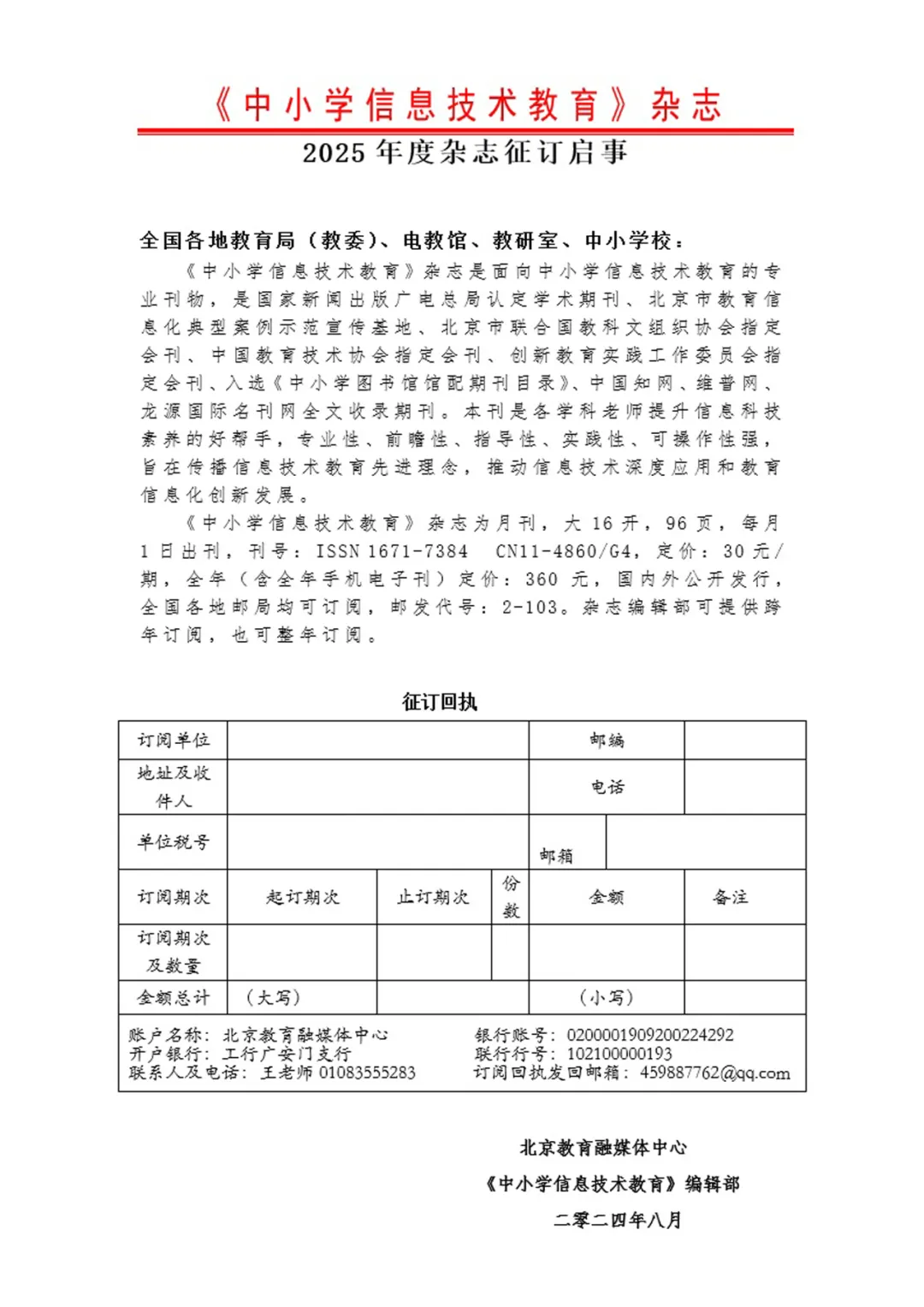
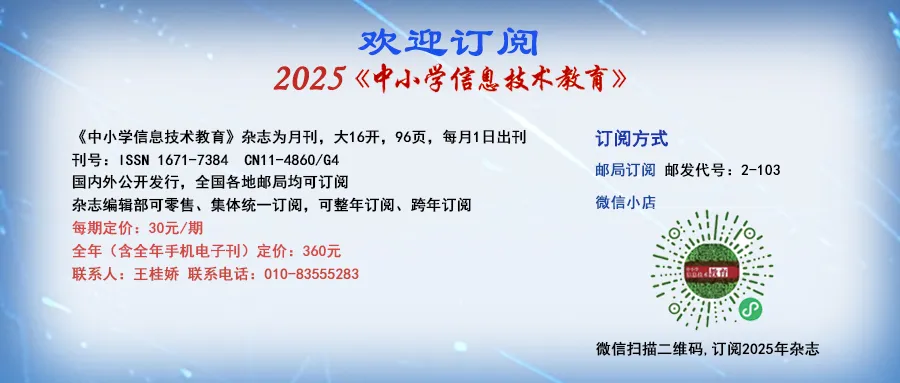
Click on the images above to enter the magazine’s online subscription pageImportant Reminder
Recently, some teachers received the following manuscript notification and certificate, both of which are counterfeit documents and seals.
Special Reminder! Teachers must not believe it! Do not transfer payments!
↓↓↓
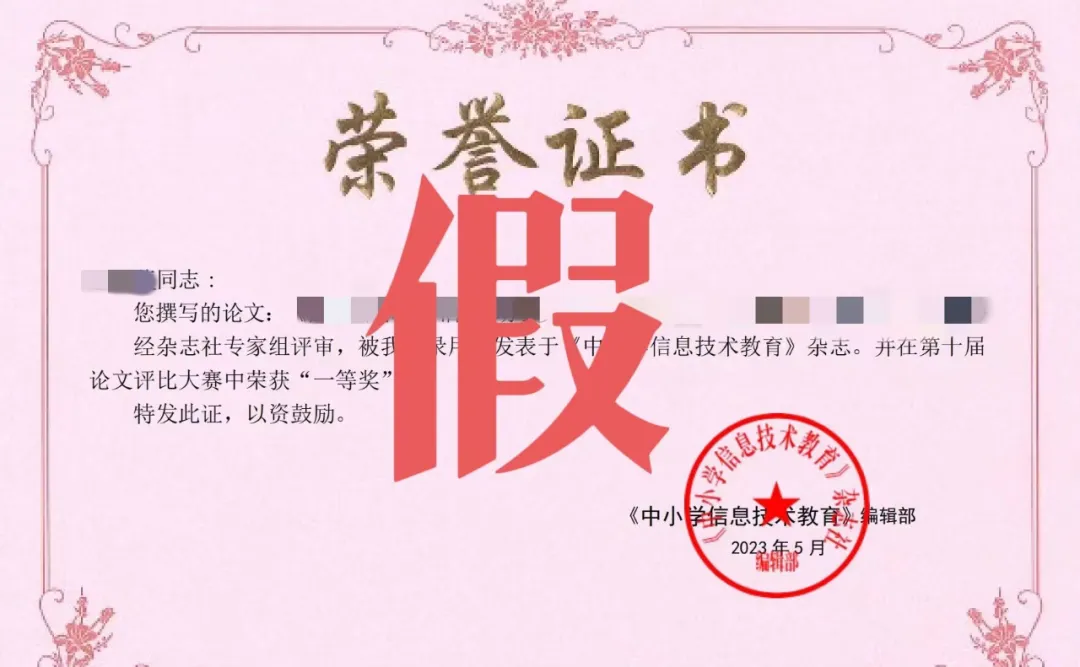
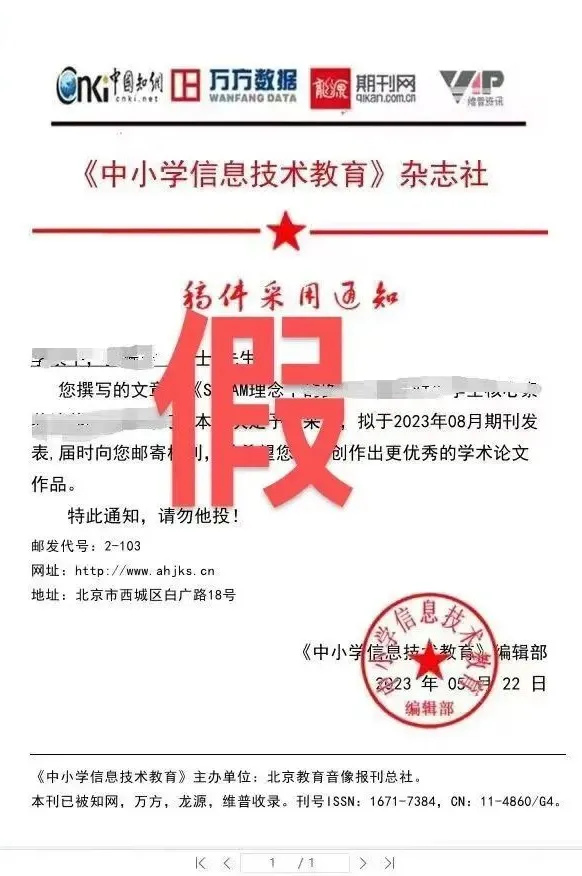
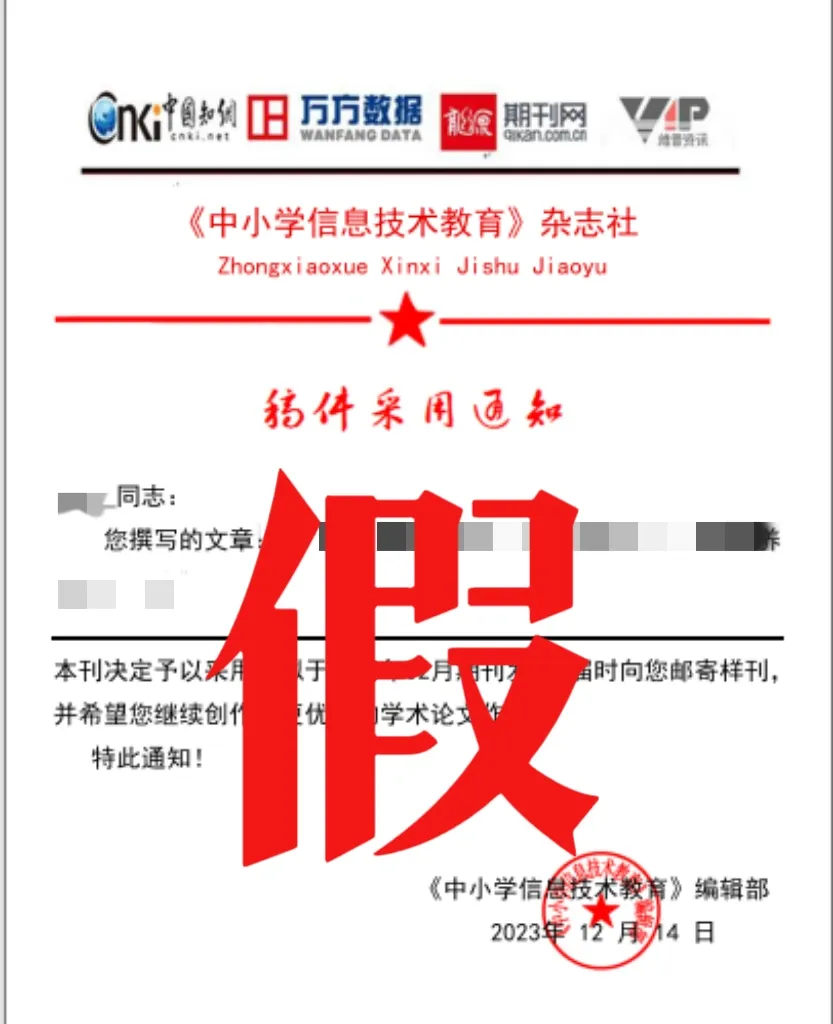
Please recognize the official submission email ([email protected]) and the WeChat mini-program “Journal of Information Technology Education for Primary and Secondary Schools” for submissions.
Typesetting | Yi Dan Initial Review | Zhang YingRe-examination | Lu Qiuhong Final Review | Su Jin Zhu If you like this article, don’t forget to click “Looking” for support~
If you like this article, don’t forget to click “Looking” for support~ Exciting content you want to seeis here
Exciting content you want to seeis here
New Issue Dispatch│2024 Issue 10Magazine Directory
Benefits are here! Welcome to subscribe to the “Journal of Information Technology Education for Primary and Secondary Schools” 2024 edition
Call for Papers! Welcome to participate in the 2024 “Digital Empowerment of Primary and Secondary School Teaching Practice” paper collection activity
The 2024 Collection of Innovative Applications of Information Technology for Primary and Secondary School Students has begun
I knew you were “Looking”
